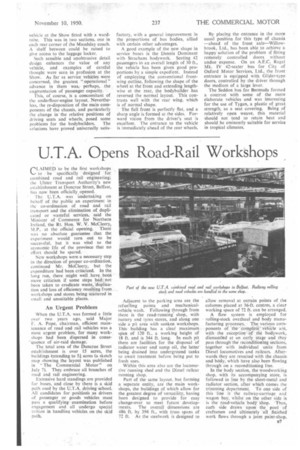U.T.A. Opens Road-Rail Workshops
Page 41

If you've noticed an error in this article please click here to report it so we can fix it.
(NAMED to be the first workshops
to be specifically designed for combined road and rail engineering; the Ulster Transport Authority's new establishment at Duncrue Street, Belfast, has now been officially,opened. The U.T.A. was undertaking on behalf of the public an experiment in the co-ordination of road and rail transport and the elimination of duplicated or wasteful services, said the Minister of Commerce for Northern Ireland, the Rt. Hon. W. V. McCleery,
M.P.. at the official opening. There was no absolute guarantee that the experiment would turn out to be successful, but it was vital to the economic life of the province that no effort should be spared.
New workshops were a necessary step in the direction of proper co-ordination, continued Mr. McCleery, but the expenditure had been criticized. In the long run, there might well have, been more criticism if some steps hiCnot been taken to eradicate waste,'duplication and loss of efficiency resulting from workshops and stores being scattered in small and unsuitable places.
An Urgent Problem When the U.T.A. was formed a little over two years ago, said Major F. A. Pope, chairman, efficient maintenance of road and rail vehicles was a most urgent problem, for many workshops had been dispersed in consequence of air-raid damage.
The total area of the Duncrue Street establishment is over 15 acres, the buildings Cxtending to 5! acres (a sketch map showing the layout was published in "The Commercial Motor" on July 7). They embrace all branches of road and rail engineering.
Extensive hard standings are provided for buses, and close by there is a skid path used by the U.T.A. driving school. All candidates for positions as drivers of passenger or goods vehicles must pass a qualifying examination before engagement and all undergo special tuition in handling vehicles on the skid path.
Adjacent to the parking area are the refuelling points and mechanicalvehicle wash. Following through from there is the road-running shop, with battery and tyres stores, and along one side a pit area with sunken workshops. This building has a clear maximum span of 120 ft., a working height of 18 ft. and is 344 ft. long. In each pit there are facilities for the disposal of radiator water and sump oil, the latter being drained into underground tanks to await treatment before being put to fresh uses.
Within this area also are the locomotive running shed and the Diesel railcar running shop.
Part of the same layout, but forming a separate entity, are the main workshops, the buildings of which allow for the greatest degree of versatility, having been designed to provide for easy change-over to meet future developments. The overall dimensions are 486 ft. by 396 ft., with truss spans of 72 ft. As the steelwork is designed to
allow removal at certain points of the columns placed at 36-ft. centres, a clear working space of 72 ft. can be arranged.
A flow system is employed for rolling-stock overhaul and body manufacturing processes. The various components of the complete' vehicle are, with the exception of the bodywork, dismantled at an early stage and they pass through the reconditioning sections, together with individual units from Diesel locomotives and railcars. Afterwards they are reunited with the chassis and body, which have also been flowing through on a reconditioning line.
In the body section, the woodworking shop, with its accompanying store, is followed in line by the sheet-metal and radiator section, after which comes the trimming department, To one side of this line is the railway-carriage and wagon bay, whilst on the other side is is the road-vehicle body shop. Thus, each side draws upon the pool 'of craftsmen and ultimately all finished work flows through a joint paint-shop.




















































































